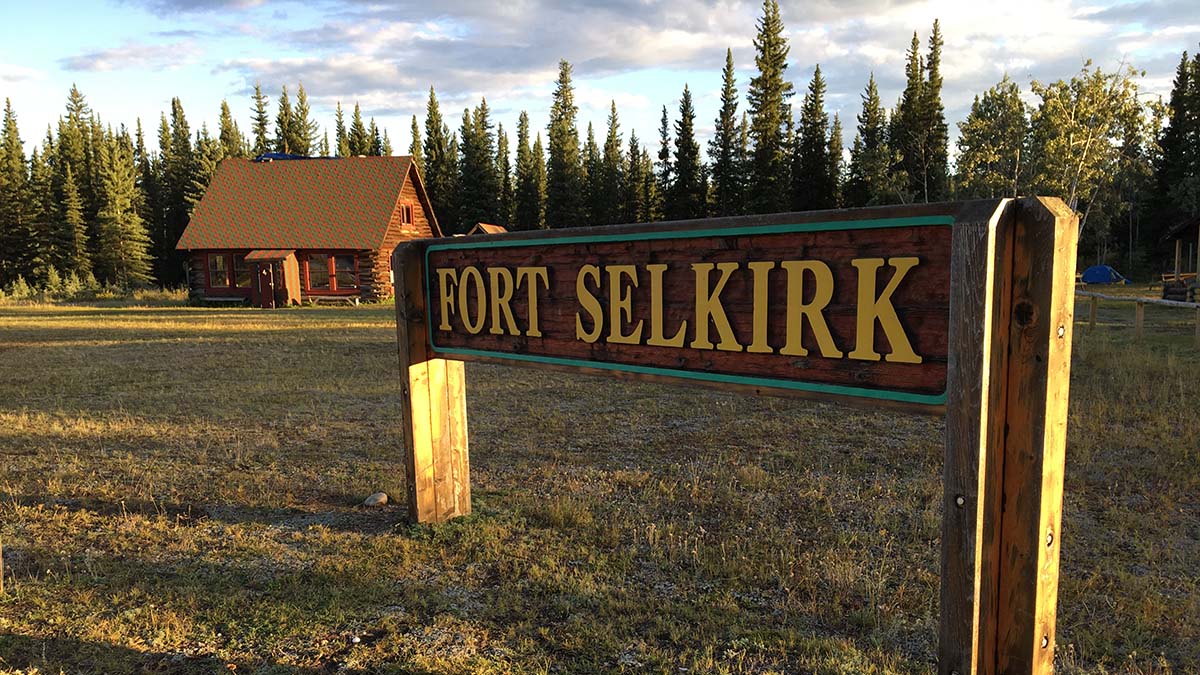
by John Geary
Walking across the grassy field to the Stone House Interpretive Centre, it was almost as if you could still hear people talking, going about their daily business as usual among the log buildings scattered around on top of the bluff overlooking the Yukon River.
Of course, no one had lived permanently at Fort Selkirk in the Yukon Territory since the 1950s, when the highway between Whitehorse and Dawson City went through. Prior to that, if you wanted to get from the territorial capital to the settlement, or further downriver to the city associated with the Klondike Gold Rush of the late 19th century, you had to use the river or fly in, once that type of transportation came into use.
The highway did not go anywhere near Fort Selkirk, located on the west bank of the Yukon River; at that point, the highway was several miles away over on the east side of the river.
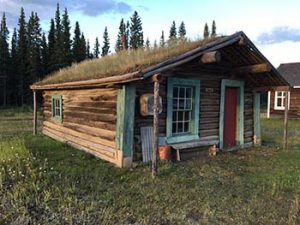 Established as a trading post by the Hudson’s Bay Company in 1852, the fort evolved into a permanent community in the early 1890s. The gold stampede swelled its population and it became a base for both the Yukon Field Force and a Northwest Mounted Police post.
Established as a trading post by the Hudson’s Bay Company in 1852, the fort evolved into a permanent community in the early 1890s. The gold stampede swelled its population and it became a base for both the Yukon Field Force and a Northwest Mounted Police post.
While it existed as a permanent community, both white and First Nations cultures worked and lived together amicably. That partnership remains today, as the Selkirk First Nation and Yukon governments co-manage the site.
Anyone doing a multi-day canoe trip on the river stops there, as there is a very nice campground for trippers next to the historic site. No matter what your paddling schedule, you’ll want to allow at least a few hours to explore the small museum and other buildings –a church, a store, residences, to name a few – to really appreciate it.
Fort Selkirk is just one of many amazing historical sites to visit in the Yukon.
And while not everyone will be up for a canoe trip to get there – or to Dawson City – you can drive from Whitehorse along Highway 2.
Dawson City really is a “living museum” with its boardwalks and clapboard-style of architecture in most of the buildings which are not residences.
Just strolling down the street looking for a place to enjoy breakfast my first morning there, I felt like I was walking in the footsteps of numerous sourdoughs (a word used for miners in the Yukon) … or maybe even in more famous footsteps – like those of authors Jack London or Robert Service, who both spent time there.
INTERPRETIVE TOURS
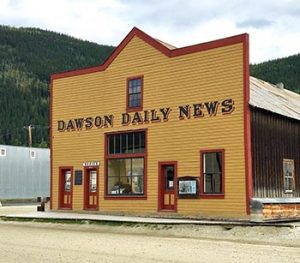 Parks Canada plays a significant role in keeping the history alive and making sure people have an opportunity to experience the site as fully as possible. One of the best ways to ensure you enjoy the full experience is to sign up for one or more of their tours at the Visitor Information Centre along the community’s Front Street, just a nugget’s throw from the river.
Parks Canada plays a significant role in keeping the history alive and making sure people have an opportunity to experience the site as fully as possible. One of the best ways to ensure you enjoy the full experience is to sign up for one or more of their tours at the Visitor Information Centre along the community’s Front Street, just a nugget’s throw from the river.
One of the first things I did was sign up for a tour that took us to the old post office, the newspaper office and a building that holds many of the archival materials dating back to the gold rush.
The tour starts off with everyone donning white gloves so as not to leave any oils or smudges on the artifacts you’ll be allowed to handle. There are several historical pieces located right in the visitor centre, and we warm up our “historical trivia minds” with some of these, as the guide prodded our curiosity by asking questions about the artifacts, testing our knowledge of the past at the same time.
Then it’s off to our next tour stop, a block or two away: the post office.
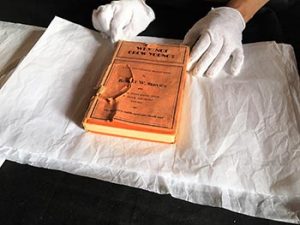 Apart from looking at the facility which used to handle all the mail coming into the centre of the Klondike gold rush, we had the opportunity to examine some more artifacts – including an original first edition book written by Robert Service.
Apart from looking at the facility which used to handle all the mail coming into the centre of the Klondike gold rush, we had the opportunity to examine some more artifacts – including an original first edition book written by Robert Service.
This book – Why Not Grow Young? – was not one of poetry, though; it was a non-fiction book he’d written about healthy practices that would help you live longer. Robert Service – an early 20th-century Dr. Oz! Who knew?
After looking at some “old mail” packages and envelopes and some post office public notices on the walls, we headed down the street to the Dawson Daily News – or what used to be the city’s newspaper office and presses. After checking out the press equipment used to print the day’s news, we had the opportunity to read some actual newspapers that were published on the very day we were visiting – but back in the early 20th century. Very interesting reading about items like the “recent Wall Street slump” and news of the Kaiser from Europe (this was before The Great War, remember). Even the ads were quite interesting: white golf sweaters for women, travel ads for rail lines and steamships, and food ads for products like “Juicy Clark’s Pork and Beans.”
Our final stop took us to a building which houses several archives not on display in the other buildings.
LITERARY HISTORY
A brisk 15-minute walk from the visitor centre takes you to the Robert Service Cabin. Again, a Parks Canada interpreter helps make the experience come alive. Dressed in the fashion style that the poet of the Yukon would have probably been decked out in, stories and poems pour forth from the guide’s mouth, painting a picture of the man who went there as a bank clerk, but grew to become the creator of such famous verses as “The Cremation of Sam McGee” and “The Shooting of Dan McGrew.” I learned that he wrote much more than poetry about the north and the gold rush; he was quite prolific when it came to poetry about the First World War, as well.
After the presentation, we spent several minutes in his restored cabin (he lived in it from 1909 to 1912), which contains some of the original historic artifacts, including a writing desk, writing materials, tools, oil lamps, wood stove, telephone and his bed.
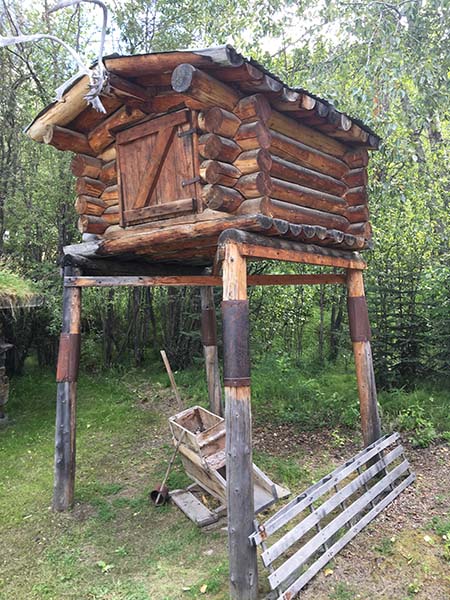 A few minutes down the road from the Service cabin sits the Jack London Museum. It contains some pieces of the original cabin the American author stayed in during his foray into gold-seeking; half of the logs are here, the other half at a similar museum in San Francisco, where he lived in the U.S. The museum contains several photos and other memorabilia pertaining to London’s time in the Yukon, and a video display that continually rotates Hollywood movies based on his writing. An interpreter gives talks about his life at several times during the day.
A few minutes down the road from the Service cabin sits the Jack London Museum. It contains some pieces of the original cabin the American author stayed in during his foray into gold-seeking; half of the logs are here, the other half at a similar museum in San Francisco, where he lived in the U.S. The museum contains several photos and other memorabilia pertaining to London’s time in the Yukon, and a video display that continually rotates Hollywood movies based on his writing. An interpreter gives talks about his life at several times during the day.
While you’re in the neighbourhood, take a few minutes to take a quick look at the Pierre Berton home across from the Service cabin. A resident of the community as a boy growing up, the Canadian author was a big advocate of his hometown and its history.
PADDLEWHEELER ADVENTURES
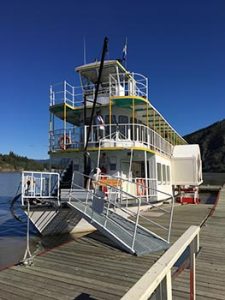 Another historic site worth checking out is the SS Keno. The old sternwheeler is berthed in a dry dock on the waterfront. Built in 1922 by the British Yukon Navigation Company, it steamed along transporting silver, zinc and lead ore down the Stewart River from mines in the Mayo district to the confluence of the Yukon and Stewart rivers at Stewart City. It was retired from commercial service in 1951, again because of highway construction.
Another historic site worth checking out is the SS Keno. The old sternwheeler is berthed in a dry dock on the waterfront. Built in 1922 by the British Yukon Navigation Company, it steamed along transporting silver, zinc and lead ore down the Stewart River from mines in the Mayo district to the confluence of the Yukon and Stewart rivers at Stewart City. It was retired from commercial service in 1951, again because of highway construction.
Better still, why not take a step back into time and ride on a paddlewheeler like the old sourdoughs use to sail up and down the river on?
The Klondike Spirit cruises up and down the Yukon with several tours daily on most days from mid-May to early September. An interpreter explains what you see along the way; you’ll see a paddlewheeler graveyard, a First Nations community, and the spot where an old hermit used to live just upstream and across the river from the city.
DON’T FORGET THE NIGHTLIFE!
Before leaving Dawson City for other adventures, you’ll want to check out some of the nightlife that recalls the kinds of entertainment enjoyed by the sourdoughs. A trip to Diamond Tooth Gertie’s with its turn-of-the-century stage shows is a must-see.
SourToe Cocktail
Whether you check out the dance hall girls or not, you’ll probably regret not joining the SourToe Club before leaving Dawson. Go to the Sourdough Saloon and ask for Captain River Rat. Then you purchase a shot of your choice – rye whisky, rum, vodka, or as many choose, Yukon Jack. I opted for rye when I did it, as they were out of YJ.
Then you just take the “SourToe Oath,” watch as an actual dehydrated human toe is added to your drink, and cheers! Down it (the booze, not the toe!) and you’re in!
There’s an interesting story about how this tradition began, but I’ll let you discover just what that is when you go for your cocktail.
Just remember, there is one rule: “You can drink it fast, you can drink it slow, but your lips have gotta touch the toe!”
And look at it this way: your lips are touching a part of history. And isn’t that what this journey is all about?
If You Go:
Getting there
The starting point for any trip to the Yukon is Whitehorse. Both Air Canada and Air North fly in to the territorial capital regularly.
For planning your trip itinerary, start with the Travel Yukon website; it can give you lots of ideas and contact information to help you plan your trip:
From Whitehorse, you can either fly into to Dawson City or drive Highway 2. There are car rental agencies in the capital.
If you have a mind to canoe on the Yukon River to see Fort Selkirk, Up North Adventures can supply gear, food, and guides.
Other helpful links:
Klondike Spirit Paddlewheeler Cruises
Parks Canada Klondike Historic Sites
About the author:
John Geary is a full time freelance writer-photographer based in Vancouver, B.C. He often specializes in stories that involve paddling and bird/wildlife watching but has always been an avid history buff since the fifth grade, when he heard tales of Marco Polo that kick-started his longing for exploration and adventure.
Photos by John Geary
- The edge of the Fort Selkirk historic site
- One of the homestead buildings at Fort Selkirk
- The newspaper office
- One of the artifacts in the post office: An original Robert Service book
- A food cache outside the Jack London Museum
- All aboard! The Klondike Spirit is getting ready to shove off

